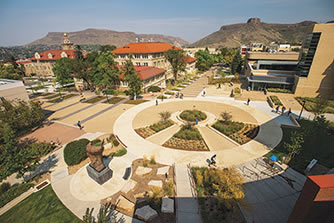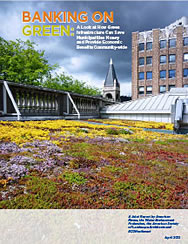Green Infrastructure and Low Impact Development
 In addition to the EPA and states and municipalities, other agencies and organizations are addressing the issue of development and the impact of stormwater runoff on the environment and society. Low Impact Development (LID) and Green Infrastructure (GI)has emerged as an attractive approach to controlling stormwater runoff pollution and protecting watersheds. LID attempts to replicate pre-development hydrology to reduce the impacts of development. By addressing runoff close to the source, LID can enhance the environment and protect the public while saving developers and local municipalities money.
In addition to the EPA and states and municipalities, other agencies and organizations are addressing the issue of development and the impact of stormwater runoff on the environment and society. Low Impact Development (LID) and Green Infrastructure (GI)has emerged as an attractive approach to controlling stormwater runoff pollution and protecting watersheds. LID attempts to replicate pre-development hydrology to reduce the impacts of development. By addressing runoff close to the source, LID can enhance the environment and protect the public while saving developers and local municipalities money.
One of the primary goals of LID and GI design is to reduce runoff volume by infiltrating rainwater into the ground and finding beneficial uses for water instead of pouring it down storm sewers. Some of these runoff control objectives include reducing impervious cover, preserving and recreating natural landscape features and facilitating infiltration opportunities. LID principles are based on the premise that stormwater management should not be simply stormwater disposal, but instead that numerous opportunities exist within a developed landscape to control stormwater close to the source. This allows development to occur with low environmental impact. Stormwater runoff from impervious surfaces is threatening rivers and ecosystems across the country. Several areas in the United States are experiencing some of the worst drought conditions in recorded history. The drought is so severe in some cases, that potable water supplies for many cities are being impacted. Infiltration technologies advocated by LID and GI, such as permeable interlocking concrete pavements, offer a way to help filter precious rainwater back into the earth and recharge groundwater.
Research has shown that green infrastructure provides not only an environmental benefit, but also an economic one. A number of studies are demonstrating that green infrastructure saves money. Banking On Green: A Look at How Green Infrastructure Can Save Municipalities Money and Provide Economic Benefits Community-wide, is a 44-page report by American Rivers, the American Society of Landscape Architects, ECONorthwest, and the Water Environment Federation. The report found that not only does green infrastructure cost less, but these practices can further reduce costs of treating large amounts of polluted runoff, can help municipalities reduce energy expenses, can reduce flooding and related flood damage, and can improve public health. The report features case studies from cities saving money and enjoying the other benefits of green infrastructure.

The impacts of stormwater pollution and the need to provide stormwater prevention, management, and treatment all create costs for communities and their residents. These costs can often be offset or reduced by making different choices about how we build communities and infrastructure.
By incorporating “green infrastructure” practices in efforts to control stormwater runoff, communities and property developers can reduce energy costs, diminish the impacts of flooding, improve public health, and reduce overall infrastructure costs. In addition, these practices, which rely on natural processes like evaporation, infiltration, and plant transpiration, can effectively and affordably complement traditional “grey” infrastructure, giving stormwater managers the ability to create integrated solutions to better serve their communities.
Banking on Green
Permeable pavements, such as our Eco-Stone® Family of Permeable Pavers, are suggested as one of the ten common LID practices and are widely used in GI streetscape and parking projects. The EPA is recommending the use of LID and GI to manage stormwater runoff and has developed an extensive number of website pages, references and guidance documents on the subject. Please see our EPA page for a comprehensive list.
A number of agencies and organizations have developed Green Rating Systems, such as LEED®, Sustainable Sites™ and Envision™, encompassing everything from green buildings to highways. In addition, most states and many municipalities have developed low impact and green infrastructure programs and governing guidance. Please visit our Green and Low Impact Development Rating Systems, Organizations, Stormwater Green Infrastructure and Guidance, Incentives, Credits and Rebates, Links and Federal Agencies pages for more detailed information.
Quick Links
- Traditional and Permeable Galleries
- Traditional Pavers
- Permeable Pavers
- Eco-Stone PowerPoint Presentation
- Eco-Stone Family of Permeable Interlocking Concrete Pavers Project Profiles
- NEW! Street, Large-Scale and Industrial Pavements
- Installation and Specifications
- Design Manuals and Literature
- Software and Presentations
- Articles and Case Studies
- Cross-Sections
- Videos
- Visit our Downloads page to access over 175 items in one place, including design manuals, case studies, articles, research papers and more

